Three-thread overlock: how to choose, fill and set up?

Overlock is a type of automatic (motorized) sewing machine, allowing to make sheathing of the edges of easily dissolving fabric around the perimeter, to stitch the product with two or more seams to give it strength. In some cases, an overlock is an assistant in the design of an item of clothing, linen or an accessory. This is achieved by working with two or more upper threads at the same time.
How to choose?
There are at least several selection criteria.
- The quality of execution. Let's say you want a model that will last at least a few years in daily or weekly use. Inspect carefully, compare different models. To get started, check out the reviews of at least a dozen models in the lower and middle price ranges. It is important to count on long and frequent work - parts made of high-quality steel, possibly stainless steel, with greater wear resistance, play a decisive role.
If the manufacturer "obscures" and conceals important information, such an overlock will not last even two years with active work.

- Price. The optimal ratio between price and quality is for those who want to get the most productive overlock for the same money with at least 10-20 modes, each of which produces its own seam, which is noticeably different from the others.

- Manufacturer country. If you don't trust China (sometimes there are good reasons for this) - look for American, European and Japanese overlocks, compare different brands and their models. Russian models such as Agat DonLock are a cheaper alternative to, for example, American ones from Brother.
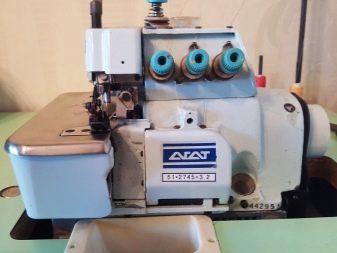

- The ability to sew, sew under a flat seam around the perimeter (and not only) any fabric - even wool and felt, from which blankets and blankets are made. A good machine will readily "pierce" even leather and leatherette, drape and other, denser matter.

- Possibility to put as large spools as possible, spools of thread. They will come in handy when a home craftswoman suddenly retrained into a “homeworker”, working to order, and quickly “overgrown” with hundreds of nearby clients. The dimensions of the machine, which allow starting the bobbins of the upper threads, is an economically more profitable solution than buying a palette (set) of small spools "for all occasions."

- Additional functions. A number of models have, for example, thread trimming - using the auxiliary cutter included in the kit.
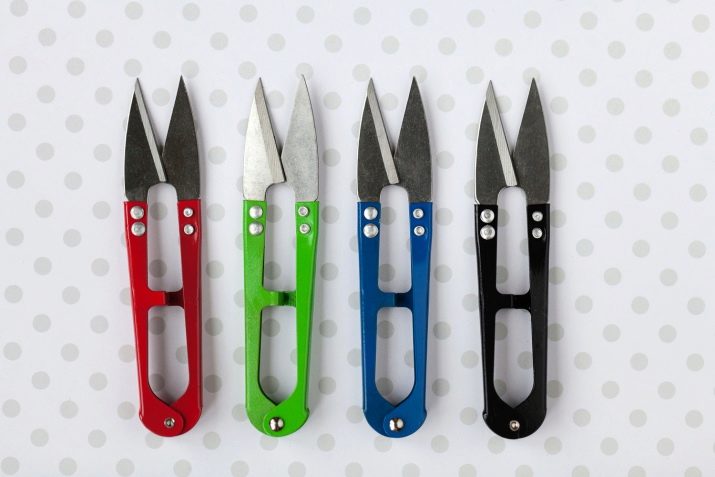
Once you have selected a high quality device that meets your requirements, read the instructions for use and thread your overlock.
Three-thread overlock
Unlike a sewing machine, whose equipment with threads for the upcoming sewing does not affect the formation of overlap stitches, and the lines do not indicate the presence of defective work, the overlock behaves differently. Any one missed thread attachment in the stapler will immediately give out skipped stitches or the seam will take on an overcast appearance.

The general instructions for refueling overlocks are as follows.
- Place the spool or mini-spool of thread on the spool pin.
- Unwind some thread from the spool. Pass the end of it through the holes or hooks that give it directions. The axis of the spool retainer must line up with the line of the thread guide - this is one of the keys to a perfect seam.
- Thread the thread through the take-off and pull-up tensioners. There are overlock models that use one universal tensioner. In any case, don't miss a beat.
- Pass the thread through the thread release guide and thread into the needle. The directions of movement of the thread and matter must coincide.
- Draw the thread to the side through the slit in the presser foot.



Place a dough patch under the presser foot and pass it through. Check the quality of the seam. Incorrectly threaded threads will produce an incorrect seam. The industrial overlock of the 51st class is in great demand among beginners and average tailors - it immediately teaches seamstresses to work “on the fly”. Its threading order is as follows:
- pass the thread through the thread guide holes on the body of the product;
- pass the thread through the tensioner profile;
- Pass the thread through the lower guide, the needle and the notch of the foot, and then pull it to the side.
Check the quality of the stitches by sewing a test piece.


Threading the loopers individually
The main difference between such a filling is one looper has a tensioner under the working area of the device... To thread the right looper, pass the threads through all parts. It is useful to use threads of contrasting color - such a difference will quickly allow you to loosen or tighten the desired one.... Threading the left looper will take a little more time and effort - less access. Tweezers will help you, but if the thread hole is not very comfortable, move the needle flap back and pass the thread through the desired parts.

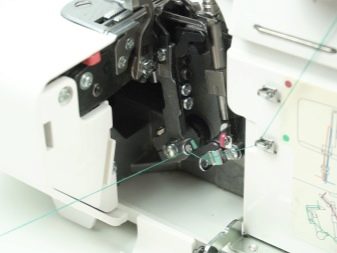
Overlock 51 class the same sequence of actions if there are four threads. The difference between refueling is as follows:
- the left needle thread tensioner has the left needle, the right needle has the right one;
- For looper tensioners, the opposite is true: the first right-hand tensioner is the first left-hand looper.
However, threading for loopers and tensioners varies from model to model.
Please check the instructions for your overlock. The four-thread overlock can have a mechanism for automatic threading into the lower looper, which simplifies the process of threading the upper threads.

Chinese 4-thread models
Overlockers ordered in China often come with a Chinese or English manual.If you haven't studied English at the engineering level, use a translator. To set up such an overlock, you need to go through 2 stages of threading the thread through the loopers. The first is to thread the left looper.
- Pass the thread through the hole in the cover cap using the thread guide itself, then guide it through the same hole on the left cover plate.
- Pass the same thread through the holes in the damper of the tensioner itself. Pass the thread through the tensioner adjuster and then through the channel to the looper.
- Rotate the pulley until the right looper is pulled upward from the plate and needle.
- Pass the thread behind the right looper lever and secure it to the hook.
- Turn the pulley until the left looper moves to the extreme position.
- Pass the thread through its hole and continue to turn the pulley until the right looper rises above the left plate. In this case, the left looper should move up to the limit.
- Place the thread under the shoulder blade.


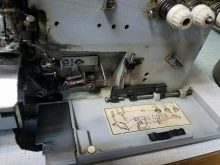
If this thread is not threaded correctly, its breakage will prevent you from making perfectly straight seams. Now thread the right looper as follows.
- Bring the thread through the hole in the tensioner plate and pass it through the eye of the needle.
- Pass the thread through the hole of the stop-setting plate of the upper cutter located in the thread tensioner through the right looper.
- Rotate the pulley so that the right looper points up.
- Thread the same thread through the hole in the looper under the hook to give it the desired direction.
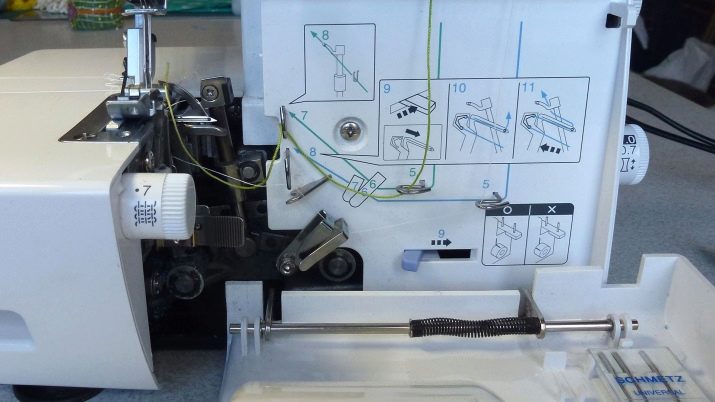
To thread the needle, do the following:
- pass the thread through the tensioner mechanism;
- go around the control shaft and pass it through the hole in the plate;
- Pass the thread under the crochet hook and thread it into the end of the needle.
Then the thread is pulled out to the side through the cut of the foot. The overlocker is ready to sew. Place under the presser foot and stitch a dough piece to check the quality of the seam. The threading scheme through all external functional units of the overlock is duplicated under the cover.
If you break it, then when you try to work on an incorrectly tucked overlock, you can not only get a fuzzy and twisted seam, but also ruin the item of linen or clothing being repaired.

Chinese three-thread
Refueling of Chinese "three-thread" machines is no different from preparing an industrial model of the 51st class or from Russian three-thread products of the "Agat" brand. The latter are inferior in design to foreign devices, for example, the Brother brand, but in functionality they are not inferior to them or any other brands.


Conclusion
An overlocker is the next step for seamstresses who have completed the initial level of sewing on a regular (household) sewing machine. You can, of course, hem the edges, bending them, however, industrial sewing at this stage is mainly sewing the edges without bending them under the "machine" seams. The "overlock" seam is less expensive, since only threads are spent, and not extra strips of fabric along with them.

An overview of the Chinese class 51 three-thread overlock is presented below.








